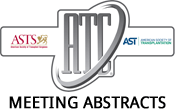2018 American Transplant Congress
Human Urine-Derived Stem Cells Protect Renal Function by Releasing miR-129-5p Which Targets High-Mobility Group Box-1 (HMGB1) in Rat Ischemia Reperfusion Injury Model
Objective: This study investigated the protective effect of human urine-derived stem cells (USCs) on renal ischemia reperfusion injury (IRI) in rats. Methods: Human USCs was…2018 American Transplant Congress
Glycogen Synthase Kinase 3 beta Regulates Liver Inflammation Activation and Resolution by Controlling AMPK Activities
Background & Aims: Glycogen synthase kinase 3β (Gsk3β) is ubiquitously expressed with distinctive functions in different types of cells. Although its roles in regulating innate…2018 American Transplant Congress
Targeting LTβR Classical NFκB Signaling Facilitates Inflammation Resolution
Background:Contact hypersensitivity (CHS) is a reliable model to assess the immune cell-mediated cutaneous inflammatory response, which includes the three phases of priming/sensitization, elicitation, and resolution,…2018 American Transplant Congress
PGE2/Beta-Catenin/XBP1 Signaling Controls Mesenchymal Stem Cell-Mediated Immune Regulation in Liver Ischemia and Reperfusion Injury
The Dumont-UCLA Transplant Center, Department of Surgery, Los Angeles, CA.
Background: Mesenchymal stem cells (MSCs) display profound immunomodulatory properties and tissue repairing capability under inflammatory conditions. However, it is unknown how MSCs may affect immunity…2018 American Transplant Congress
Targeting Lymphotoxin Signaling in Lymphatics Regulates Immune Sensitization, Elicitation, and Resolution
Background:Contact hypersensitivity (CHS) is a T cell-mediated cutaneous inflammatory response which includes three phases of priming/sensitization, elicitation, and resolution,mirroring many aspects of allogeneic responses. The…2017 American Transplant Congress
Ischemia-Reperfusion Injury-Induced Innate Immune Signaling in Human Orthotopic Liver Transplantation.
Background: Ischemia-reperfusion injury (IRI) is a major risk factor in the development of acute and chronic graft rejection in orthotopic liver transplantation (OLT); however, no…2017 American Transplant Congress
Immunosuppressive Ability of NFkB Inhibitor: Withaferin A.
BackgroundThe advent of steroid-free protocol by the Edmonton group encouraged islet transplant as a therapy for Type-1 Diabetes. However, long-term dysfunction in islet transplantation is…2017 American Transplant Congress
Proteasome Modulation an Effective Strategy to Ameliorate Steatotic Liver Grafts Viability After Preservation.
Recently we provided evidence for a possible protective role of proteasome inhibition during liver graft preservation. Although, several reported data confirmed that the proteolytic activity…2017 American Transplant Congress
Maintenance of the Phenotype and Abundance of Islet-Resident Macrophages Promotes Islet Graft Survival and Appears to Prevent Type 1 Diabetes.
Department of Medicine, Beth Israel Deaconess Medical Center, Boston, MA
Immunoregulatory tissue resident macrophage subsets have been reported in skin, heart, lung and adipose tissue.We now demonstrate the existence of a functionally immunoregulatory population of…2017 American Transplant Congress
Contribution of γδ T-Cell Subsets and IL-17A Release to Ischemia Reperfusion Injury (IRI) and Kidney Allograft Rejection in Mice.
Ischemia reperfusion injury (IRI) contributes to acute allograft injury and to delayed graft function (DGF) which is a trigger for acute rejection after kidney transplantation…
- « Previous Page
- 1
- …
- 23
- 24
- 25
- 26
- 27
- …
- 41
- Next Page »
